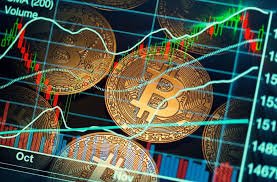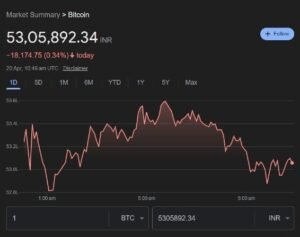Following the Halving event on April 20, industry experts suggest that Bitcoin is unlikely to experience significant price increases in the next few weeks. This fourth Halving occurred amidst ongoing volatility in crypto prices, influenced by macroeconomic and geopolitical uncertainties.
 Despite this, Bitcoin continues to receive some support, particularly from the institutionalization of the token through the approval of Bitcoin Spot ETFs in the US and Hong Kong.
Despite this, Bitcoin continues to receive some support, particularly from the institutionalization of the token through the approval of Bitcoin Spot ETFs in the US and Hong Kong.
Halving takes place every four years, halving the reward for mining new Bitcoins.
According to Sidharth Sogani, co-founder and CEO at crypto research firm CREBACO Global, there hasn’t been an immediate impact, with prices remaining relatively stable.
Sogani noted, “Going by past trends, it typically takes about three to four weeks after Halving for prices to rise.” He also stated that the anticipated price surge leading up to the Halving event occurred earlier than expected due to the Bitcoin ETF approval. Sogani predicts that it may take another three to four months post-Halving for Bitcoin to reach new all-time highs.
Bitcoin halving
The Halving event is a significant occurrence in the cryptocurrency world that happens approximately every four years. Initially, when the cryptocurrency was introduced, its design ensured that the total supply would be capped at 21 million units.
To obtain rewards, miners engage in solving complex mathematical problems, which ultimately add transaction blocks to the blockchain network. Every 210,000 blocks of transactions, roughly taking four years to complete, trigger a Halving event. This event results in the number of rewards mined being halved.

The first Halving took place in 2012, reducing miner rewards by half. Subsequently, in 2016, the event further halved the rewards. During the 2020 Halving, amidst a global boom in the crypto industry, rewards decreased.
Following the recent Halving, rewards have now been halved again.
On April 19, the cryptocurrency experienced a scheduled decrease in its rate of new coin creation. This occurrence, referred to as a “Halving,” takes place approximately every four years and aims to curb the total supply of the cryptocurrency, according to CoinGecko.
According to data, the cryptocurrency’s dominance currently stands at 54.14 percent, reflecting a slight increase over the day.
Despite the Halving event, the cryptocurrency’s price remained relatively stable, with a minor decline, settling at ₹58,89,117 on Wazirx.
Cryptocurrency enthusiasts had high expectations for this event, believing it would further establish the cryptocurrency’s value as a scarce asset. The cryptocurrency’s founder imposed a limit on its total supply.
The Halving occurred amidst a period of notable price fluctuations. Although it reached an all-time high in March 2024, it has since retraced somewhat. Additionally, the broader cryptocurrency market has seen optimism due to recent developments such as the approval of spot ETFs in the United States and expectations of lower interest rates.
 The markets were already factoring in the impending Halving, leading to minimal volatility close to the event, according to Parth Chaturvedi, Investments Lead at CoinSwitch Ventures. He noted a notable divergence between declining tech stock prices and rising cryptocurrency prices, signaling crypto’s emergence as a distinct asset class.
The markets were already factoring in the impending Halving, leading to minimal volatility close to the event, according to Parth Chaturvedi, Investments Lead at CoinSwitch Ventures. He noted a notable divergence between declining tech stock prices and rising cryptocurrency prices, signaling crypto’s emergence as a distinct asset class.
Chaturvedi pointed out that while geopolitical tensions have dampened prices from their recent highs, near-term downward pressure may persist as miners and ecosystem participants adapt to the altered supply dynamics post-Halving.
With cryptocurrency’s annual inflation now lower than gold’s following the fourth Halving, Chaturvedi anticipates increased interest from investors in cryptocurrency as a ‘store of value’ asset.
Mridul Gupta, COO of CoinDCX, emphasized that as the supply becomes constrained post-Halving, cryptocurrency prices are likely to rise in the long run, mirroring past Halving trends. However, Gupta cautioned against expecting significant price jumps in the short term, suggesting that over the next 30-45 days, such trends might be challenging to discern.
Nonetheless, he anticipates that the reduction in rewards and subsequent decrease in supply volume will exert upward pressure on prices over time.










